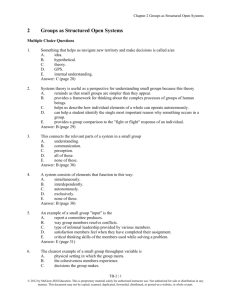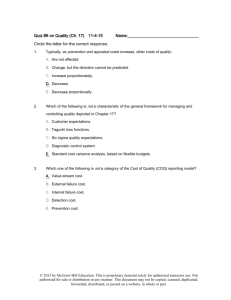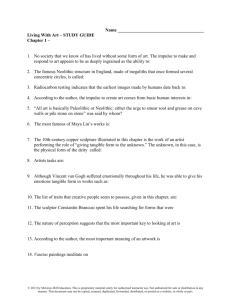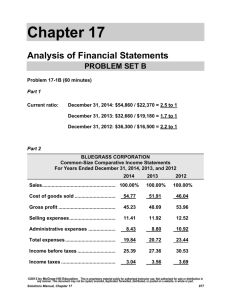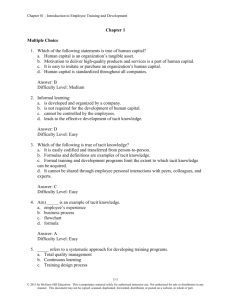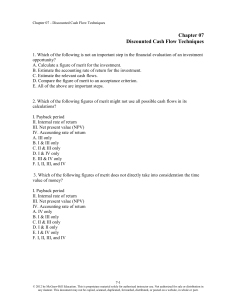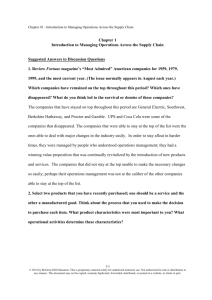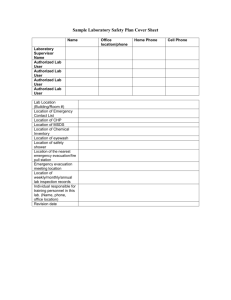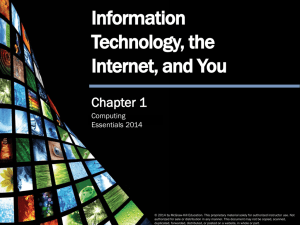The System Unit
advertisement
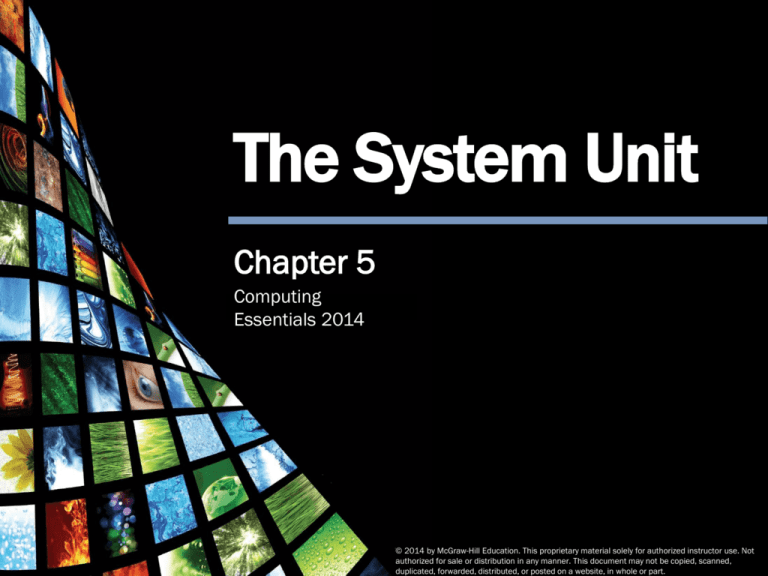
The System Unit Chapter 5 Computing Essentials 2014 The System Unit Computing Essentials 2014 © 2014 by McGraw-Hill Education. This proprietary material solely for authorized instructor use. Not © 2014 by McGraw-Hill Education. This proprietary material solely for authorized instructor use. Not authorized for sale for or distribution in any manner. This document may notmay be copied, scanned, authorized sale or distribution in any manner. This document not be copied, scanned, duplicated, forwarded, distributed, or posted on a website, in whole or part. duplicated, forwarded, distributed, or posted on a website, in whole or part. Competencies (1 of 2) Describe the four basic types of system units. Describe system boards, including sockets, slots, and bus lines. Discuss microprocessors, including microprocessor chips and specialty processors. Discuss memory including RAM, ROM, and flash memory. The System Unit Computing Essentials 2014 © 2014 by McGraw-Hill Education. This proprietary material solely for authorized instructor use. Not authorized for sale or distribution in any manner. This document may not be copied, scanned, duplicated, forwarded, distributed, or posted on a website, in whole or part. 2 Competencies (2 of 2) Discuss expansion slots and cards. Describe bus lines, bus widths, and expansion buses. Describe ports, including standard and specialized ports. Discuss power supply for desktop, notebook, tablet, and handheld computers . Discuss how a computer can represent numbers and encode characters electronically. The System Unit Computing Essentials 2014 © 2014 by McGraw-Hill Education. This proprietary material solely for authorized instructor use. Not authorized for sale or distribution in any manner. This document may not be copied, scanned, duplicated, forwarded, distributed, or posted on a website, in whole or part. 3 Introduction Speed, capacity, and flexibility determine the power of microcomputers. Knowledge of a computer’s power allows you to make good buying decisions and to determine if your current system will run new applications. Competent end users need to understand the basic principles of how microcomputers are put together. The System Unit Computing Essentials 2014 © 2014 by McGraw-Hill Education. This proprietary material solely for authorized instructor use. Not authorized for sale or distribution in any manner. This document may not be copied, scanned, duplicated, forwarded, distributed, or posted on a website, in whole or part. 4 System Unit Types Desktops Tower Unit, All-in-one Notebooks Laptops Netbooks Tablets Handhelds The System Unit Computing Essentials 2014 © 2014 by McGraw-Hill Education. This proprietary material solely for authorized instructor use. Not authorized for sale or distribution in any manner. This document may not be copied, scanned, duplicated, forwarded, distributed, or posted on a website, in whole or part. 5 Making IT Work for You ~ Keeping Your Computer Cool Computer components generate a significant amount of heat Can damage your system Notebooks present a special challenge The System Unit Computing Essentials 2014 © 2014 by McGraw-Hill Education. This proprietary material solely for authorized instructor use. Not authorized for sale or distribution in any manner. This document may not be copied, scanned, duplicated, forwarded, distributed, or posted on a website, in whole or part. 6 System Board Main board or motherboard Controls communications Components connect to the system board Data path Traffic monitor The System Unit Computing Essentials 2014 © 2014 by McGraw-Hill Education. This proprietary material solely for authorized instructor use. Not authorized for sale or distribution in any manner. This document may not be copied, scanned, duplicated, forwarded, distributed, or posted on a website, in whole or part. 7 System Board Components (Page 1 of 2) Sockets Connection point for chips Chips Tiny circuit boards etched onto squares of silicon Silicon chip, semiconductor, or integrated circuit Mounted on carrier packages The System Unit Computing Essentials 2014 © 2014 by McGraw-Hill Education. This proprietary material solely for authorized instructor use. Not authorized for sale or distribution in any manner. This document may not be copied, scanned, duplicated, forwarded, distributed, or posted on a website, in whole or part. 8 System Board Components (Page 2 of 2) Slots Provide a connection point for specialized cards or circuit boards Bus lines Provide pathways that support communication among the various electronic components The System Unit Computing Essentials 2014 © 2014 by McGraw-Hill Education. This proprietary material solely for authorized instructor use. Not authorized for sale or distribution in any manner. This document may not be copied, scanned, duplicated, forwarded, distributed, or posted on a website, in whole or part. 9 Microprocessor Central Processing Unit (CPU) Contained on the microprocessor chip Brains of the computer Two Basic Components Control unit Arithmetic-logic unit (ALU) The System Unit Computing Essentials 2014 © 2014 by McGraw-Hill Education. This proprietary material solely for authorized instructor use. Not authorized for sale or distribution in any manner. This document may not be copied, scanned, duplicated, forwarded, distributed, or posted on a website, in whole or part. 10 Microprocessor Chips (Page 1 of 2) Chip capacities expressed in word size Word The number of bits that can be processed at one time 64-bit standard Clock Speed Processing speed The number of times the CPU fetches and processes data or instructions in a second The System Unit Computing Essentials 2014 © 2014 by McGraw-Hill Education. This proprietary material solely for authorized instructor use. Not authorized for sale or distribution in any manner. This document may not be copied, scanned, duplicated, forwarded, distributed, or posted on a website, in whole or part. 11 Microprocessor Chips (Page 2 of 2) Multi-Core Chip Two separate and independent CPUs Parallel Processing Windows 8 and Mac OS X The System Unit Computing Essentials 2014 © 2014 by McGraw-Hill Education. This proprietary material solely for authorized instructor use. Not authorized for sale or distribution in any manner. This document may not be copied, scanned, duplicated, forwarded, distributed, or posted on a website, in whole or part. 12 Specialty Processors Coprocessors Designed to improve specific computing operations Graphics coprocessors / Graphics Processing Unit (GPU) The System Unit Computing Essentials 2014 © 2014 by McGraw-Hill Education. This proprietary material solely for authorized instructor use. Not authorized for sale or distribution in any manner. This document may not be copied, scanned, duplicated, forwarded, distributed, or posted on a website, in whole or part. 13 Expansion Slots and Cards Advanced graphics cards Sound cards Network interface cards (NIC) Wireless network cards Plug and Play The System Unit Computing Essentials 2014 © 2014 by McGraw-Hill Education. This proprietary material solely for authorized instructor use. Not authorized for sale or distribution in any manner. This document may not be copied, scanned, duplicated, forwarded, distributed, or posted on a website, in whole or part. 14 Bus Lines Also known as a bus Connect parts of the CPU to each other Pathway for bits Bus width Number of bits that can travel at once Two basic categories System buses Expansion buses The System Unit Computing Essentials 2014 © 2014 by McGraw-Hill Education. This proprietary material solely for authorized instructor use. Not authorized for sale or distribution in any manner. This document may not be copied, scanned, duplicated, forwarded, distributed, or posted on a website, in whole or part. 15 Expansion Buses Connects the CPU to other components on the system board, including expansion slots Universal Serial Bus (USB) Connects external USB devices onto the USB bus FireWire Audio and video equipment PCI Express (PCIe) Single dedicated path for each connected device The System Unit Computing Essentials 2014 © 2014 by McGraw-Hill Education. This proprietary material solely for authorized instructor use. Not authorized for sale or distribution in any manner. This document may not be copied, scanned, duplicated, forwarded, distributed, or posted on a website, in whole or part. 16 Cables Used to connect external devices to the system unit via the ports One end of the cable is attached to the device and the other end has a connector that is attached to a matching connector on the port The System Unit Computing Essentials 2014 © 2014 by McGraw-Hill Education. This proprietary material solely for authorized instructor use. Not authorized for sale or distribution in any manner. This document may not be copied, scanned, duplicated, forwarded, distributed, or posted on a website, in whole or part. 17 Making IT Work for You ~ TV Tuners Using Windows Media System as a DVR Install TV Tuner The System Unit Computing Essentials 2014 © 2014 by McGraw-Hill Education. This proprietary material solely for authorized instructor use. Not authorized for sale or distribution in any manner. This document may not be copied, scanned, duplicated, forwarded, distributed, or posted on a website, in whole or part. 18 Power Supply Computers require direct current (DC) DC power provided by converting alternating current (AC) from wall outlets or batteries Desktop computers use power supply units Notebooks and handhelds use AC adapters The System Unit Computing Essentials 2014 © 2014 by McGraw-Hill Education. This proprietary material solely for authorized instructor use. Not authorized for sale or distribution in any manner. This document may not be copied, scanned, duplicated, forwarded, distributed, or posted on a website, in whole or part. 19 Electronic Data and Instructions Digital electronic signals Recognized by computers Analog signals Created by voices Conversion must take place from analog to digital before processing can occur The System Unit Computing Essentials 2014 © 2014 by McGraw-Hill Education. This proprietary material solely for authorized instructor use. Not authorized for sale or distribution in any manner. This document may not be copied, scanned, duplicated, forwarded, distributed, or posted on a website, in whole or part. 20 Numeric Representation Binary System only two digits called bits On = 1; positive charge Off = 0; no charge Byte = 8 bits grouped together Hexadecimal system The System Unit Computing Essentials 2014 © 2014 by McGraw-Hill Education. This proprietary material solely for authorized instructor use. Not authorized for sale or distribution in any manner. This document may not be copied, scanned, duplicated, forwarded, distributed, or posted on a website, in whole or part. 21 Character Encoding Character encoding standards ASCII American Standard Code for Information Interchange Microcomputers EBCDIC Extended Binary coded Decimal Interchange Code Mainframe Unicode Uses 16 bits Recognized by virtually all computer systems The System Unit Computing Essentials 2014 © 2014 by McGraw-Hill Education. This proprietary material solely for authorized instructor use. Not authorized for sale or distribution in any manner. This document may not be copied, scanned, duplicated, forwarded, distributed, or posted on a website, in whole or part. 22 Careers In IT Computer technicians repair and install computer components and systems Employers look for: Certification Communication skills Continued education is required Computer technicians can expect to earn an annual salary of $31K to $46K The System Unit Computing Essentials 2014 © 2014 by McGraw-Hill Education. This proprietary material solely for authorized instructor use. Not authorized for sale or distribution in any manner. This document may not be copied, scanned, duplicated, forwarded, distributed, or posted on a website, in whole or part. 23 A Look to the Future Wearable computers Send and receive email while jogging Maintain your personal schedule book Remember the names of people at a party The System Unit Computing Essentials 2014 © 2014 by McGraw-Hill Education. This proprietary material solely for authorized instructor use. Not authorized for sale or distribution in any manner. This document may not be copied, scanned, duplicated, forwarded, distributed, or posted on a website, in whole or part. 24 Open-Ended Questions (Page 1 of 3) Describe the four basic types of microcomputers and microcomputer system units. Describe system boards including sockets, chips, carrier packages, slots, and bus lines. Discuss microprocessor components, chips, and specialty processors. The System Unit Computing Essentials 2014 © 2014 by McGraw-Hill Education. This proprietary material solely for authorized instructor use. Not authorized for sale or distribution in any manner. This document may not be copied, scanned, duplicated, forwarded, distributed, or posted on a website, in whole or part. 25 Open-Ended Questions (Page 2 of 3) Define computer memory including RAM, ROM, and flash memory. Define expansion slots, cards, Plug and Play, PC cards, PCMCIA slots, and Express-Card slots. Describe bus lines including bus width, system bus, and expansion bus. The System Unit Computing Essentials 2014 © 2014 by McGraw-Hill Education. This proprietary material solely for authorized instructor use. Not authorized for sale or distribution in any manner. This document may not be copied, scanned, duplicated, forwarded, distributed, or posted on a website, in whole or part. 26 Open-Ended Questions (Page 3 of 3) Define ports including standard and specialized ports. Give examples of each. Describe power supply including power supply units and AC adapters. Discuss electronic data and instructions. The System Unit Computing Essentials 2014 © 2014 by McGraw-Hill Education. This proprietary material solely for authorized instructor use. Not authorized for sale or distribution in any manner. This document may not be copied, scanned, duplicated, forwarded, distributed, or posted on a website, in whole or part. 27
